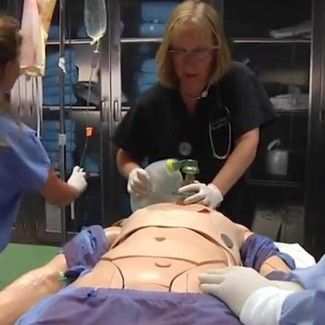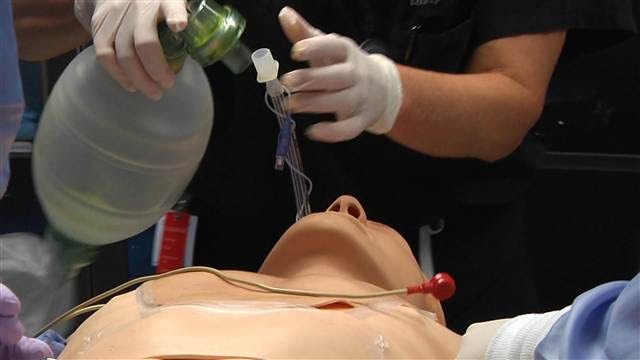Doctors Use Suspended Animation to Save Lives

It sounds like the stuff of science fiction: a mortally injured patient is put into suspended animation so doctors can buy time to close up his wounds and save his life.
But that seemingly improbable scenario is about to become a reality at five centers around the United States where doctors will try to stop the clock on patients who’ve sustained gunshot or knife wounds that were so severe their hearts stopped.
In the past, when efforts to restart the heart failed because so much blood had been lost, these patients would have been declared dead because there was no way to get enough oxygen to the brain before it was irreparably damaged.
Scientists now think that by quickly and dramatically cooling down a trauma patient by replacing blood with cold saline solution, they can send all the cells of the body into slow motion. That would mean the cells would need less oxygen, which would give doctors the time needed to make repairs that would stop the bleeding.
“They have basically suspended animation and in an animal model, there’s an amazing recovery.”

Normally, the brain would be damaged after five minutes of oxygen deprivation. But researchers suspect that by slowing cell metabolism with cold, they can stretch that five minutes to an hour or more.
Doctors at the University of Pittsburgh and four other hospitals will try dramatically cooling gunshot wound victims by replacing blood with cold saline solution, effectively suspending animation to buy more time.
Research in pigs suggests “that if we could cool a person fast enough and cold enough, we could then basically stop the clock, and that would buy time for the surgeon to get control over the bleeding,” said Dr. Sam Tisherman, a professor of critical care medicine and surgery at UPMC where trials of the technique are about to begin. “If we could get the bleeding under control, that would be a huge change for us.”
Once repairs are made, blood would be exchanged for the saline solution through a heart-lung bypass machine. This would restore circulation and bring body temperature back up to normal. In animal models, the effect has been quite stunning.
“It’s really fascinating,” said Dr. Paul Vespa, a professor of neurology and neurosurgery and director of critical care at the University of California, Los Angeles. “They have basically suspended animation and in an animal model, there’s an amazing recovery.”
Vespa, who is not involved in the study, has seen an animal go from cold and “dead” to up and walking as if nothing had happened.
At UPMC, they’re just waiting for the right patient — one with cardiac arrest due to penetrating wounds and significant blood loss — to be wheeled into the emergency room. All the paper work is done; the team is is trained and ready.
The inspiration for the research initially came from anecdotal reports of people surviving without damage even after spending an hour or more underwater without breathing. The common thread in all of those miraculous survival stories was that they occurred in water that was frigid.
“That made people think that even if our heart stopped, if you could get cold fast enough, the brain, heart and other organs might be OK,” Tisherman said.
“If you were dead for a day I would not be able to bring you back. But we’re talking about 5 to 15 minutes. If you’re cooled straight down, you have a chance.”
Surgeons are already using the principle to operate on babies born with congenital heart defects, Tisherman said.
The discovery that animals — and maybe humans — could be put into a state of suspended animation is causing scientists to redefine what “dead” means, said Dr. Peter Rhee, a professor of surgery and chief of trauma, critical care, burns and emergency surgery at the University of Arizona. When in this state, a patient would be neither dead nor alive, he explained.
Rhee has been working on suspended animation for nearly 20 years. His experiments have shown that animals could be brought back from a suspended state undamaged, “even though they were by all clinical measures dead.”
“When you stop the machinery of life, that’s not when death starts,” Rhee said. “If you were dead for a day I would not be able to bring you back. But we’re talking about 5 to 15 minutes. If you’re cooled straight down, you have a chance.”
“You may one day see ambulances come out and EMTs immediately start cooling the patient. Time is brain.”
One issue that slowed the research in humans was the impossibility of getting consent from an individual who is wheeled into the emergency room dead, for all intents and purposes. Ultimately, the way around the problem was to consent an entire community by putting word out through the media that the new technique would be tried if there was no other option.
Vespa suspects that if the trials show promising results, it will also change the way patients are treated on the way to the hospital.
“You may one day see ambulances come out and EMTs immediately start cooling the patient. Time is brain,” Vespa said.
We know that you lose two million brain cells every minute of a stroke, he added. So, “if you could completely stop the injury process you’re going to save a lot of brain cells.”
While the current state of the art suggests that you can have just a couple of hours of suspended animation, Rhee thinks the research is just at its beginning.
“A couple of hundred years ago people thought you couldn’t fly through the air,” he said. “Gliding was the beginning. These are just baby steps, this idea of putting a person in a state where they are not really alive or dead. How long can that period be? We don’t know. We are now asking the questions that might give us the answer to that.”

